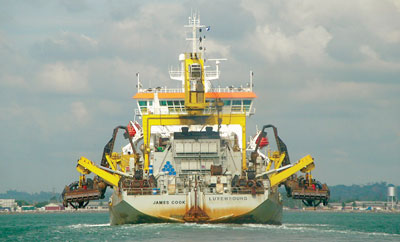

he Port of Cortes, the largest of five Caribbean ports in Honduras, manages more than 80 percent of the maritime traffic steaming from Honduras, plus cargo from Nicaragua and El Salvador. The port is the largest and deepest in Central America. A major conduit of Central American cargo, the port participates in the U.S. government’s Container Security, Megaports and Secure Freight Initiatives. It is also the only port in the Western Hemisphere – and one of just three in the world – currently scanning 100 percent of all inbound and outbound containers for radiation. And its location offers 60-hour navigation time to ports in the Southeastern U.S.
But population growth in the region and increased trade due to DR-CAFTA have the port operating beyond capacity, with four cargo ships routinely waiting in the bay for berthing space. Honduras ships fruit, tilapia, apparel and auto parts, and imports machinery and other goods. Business is steadily increasing, up 12 percent during the first six months of 2008. The port is 34 miles (55 km.) from San Pedro Sula, the industrial hub of Honduras.
To accommodate the growth, a two-phase, US$240-million project is under way to deepen the bay and add 111 acres (45 hectares) to the port’s footprint. Dredging for the project began in June. The project is being financed by the Central American Bank for Economic Integration (CABEI) and the Inter-American Development Bank (IADB).
“There is more business than we can handle, and that’s why we need the expansion,” says Robert Babun, general manager for Empresa Nacional Portuaria, the agency overseeing Honduran ports.
The expansion will include a container terminal and an organic bulk terminal. The project will also allow the port to accommodate the much larger post-Panamax container vessels.
n even larger Honduran infrastructure project than the Port of Cortes expansion is moving toward a projected 2009 completion. The $470-million “dry canal” – a four- and six-lane superhighway – will connect that port with the Port of La Union on El Salvador’s Pacific Coast. The 230-mile (371-km.) highway will allow goods to be trucked between the ports in eight hours.
The highway will bypass the capital of Tegucigalpa, eliminating a major bottleneck in the route. The project is being financed by the CABEI, USAID through the Millennium Challenge Fund and the government of Mexico. Honduras port officials view a completed dry canal as an alternative logistics corridor to the Panama Canal. While the dry canal will obviously not have the same cargo capacity, it will offer a quicker route between the Atlantic and Pacific, says Mohand Merzkani, economic and financial director for Empresa Nacional Portuaria.
“It will promote trade from East Asia,” Merzkani says.
The dry canal will combine existing highways with a new 62-mile (100-km.) section between Villa San Antonio and Goascoran, near the El Salvador border. Merzkani says the government is also studying ways to bypass San Pedro Sula, a metro area of about 1 million people.

Also see: The Original Melting Pot, featured in the July 21, 2008 Site Selection Online Insider.
Site Selection Online – The magazine of Corporate Real Estate Strategy and Area Economic Development.
©2008 Conway Data, Inc. All rights reserved. SiteNet data is from many sources and not warranted to be accurate or current.
Related Articles
TECHNOLOGY TOOLBOX
Silicon technology specialist Intel’s vast real estate portfolio includes 49 million sq. ft. (455,210 sq. m.) stretching across 200 locations in over 50 countries. A diverse company, Intel encompasses a variety of products and services. “When people think about Intel, they certainly think about microprocessors, but we have 12 major business units which we break […]
Editor’s View: On Country Mice And City Mice
Both Nebraska Governor Pete Ricketts and Texas Governor Greg Abbott are no less deserving of their respective Governor’s Cups than they were the last few times they won.
E
Those funding new Internet ventures–and those in corporate real estate to whom they are targeted–are wise to sit back for a while and let the dust settle. Consider the past 18 months. In mid-1998, perhaps a few dozen Internet operations were in place working on “Web-enabling” various real estate processes, having secured a round or […]
Tarsands Testimonial
Economist Thomas Faranda, in a spring 2011 talk before the Industrial Asset Management Council, called Canada a sleeping giant, albeit one that’s about to wake up. And its alarm clock is perched on its Western half.